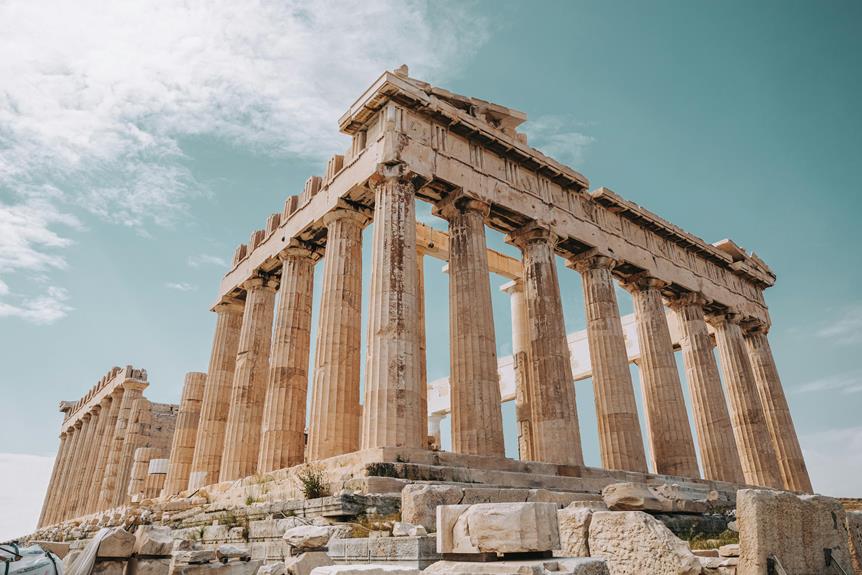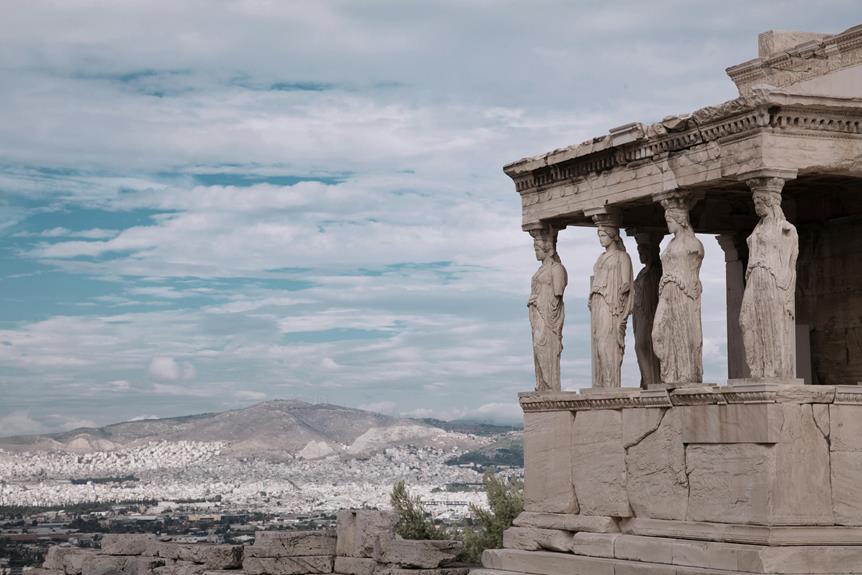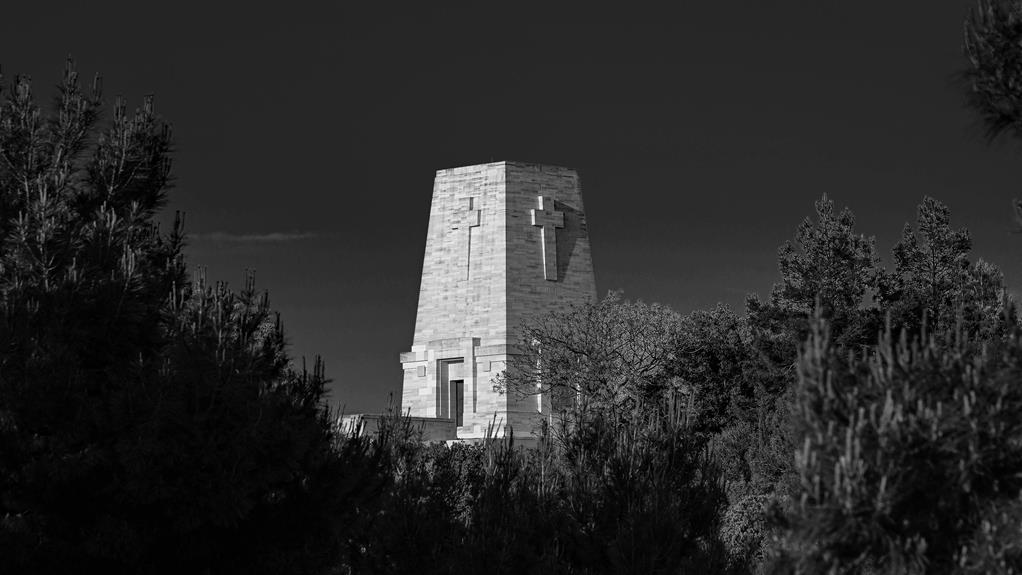Ground Zero, the solemn ground where the 9/11 Memorial now stands, encapsulates a profound narrative of loss, resilience, and remembrance. The evolving landscape of this site reflects not only the physical reconstruction post-tragedy but also the enduring impact on global consciousness and security measures. With each element meticulously designed to honor the victims and survivors, Ground Zero beckons visitors to contemplate the weight of history while urging a reflection on the lessons learned from that fateful day.
Key Takeaways
- Symbolizes resilience and unity through design and architecture.
- Features Memorial Pools in Twin Towers' footprints.
- Houses the Survivor Tree, a symbol of hope and survival.
- Showcases 9/11 Museum with interactive exhibits.
- Hosts various commemorative events honoring the victims.
History of Ground Zero
Established as the site where the World Trade Center once stood, Ground Zero holds significant historical importance due to the tragic events of September 11, 2001. This location in Lower Manhattan, New York City, became the focal point of one of the deadliest terrorist attacks in world history. The impact of this day not only shook the nation but reverberated globally, shaping policies and security measures for years to come.
The history of Ground Zero is an impactful tribute to the lives lost on that fateful day. The emotional journey that visitors undertake when they visit the site is profound and deeply moving. The memorial serves as a place of remembrance, honoring the nearly 3,000 victims who perished in the attacks. The names of all those who lost their lives are inscribed on bronze parapets surrounding the reflecting pools that now mark the footprints of the original Twin Towers.
Through exhibits, artifacts, and personal stories, the history of Ground Zero unfolds, allowing visitors to grasp the magnitude of the tragedy and the resilience of the human spirit in the face of adversity. It stands as a somber reminder of the past while also symbolizing hope for a future free from such devastation.
Design and Architecture
The design and architecture of the Ground Zero memorial in the USA showcase a blend of modern aesthetics and profound symbolism, creating a space that honors the memory of the victims of 9/11 with solemn dignity. The innovative structures and architectural significance of the memorial have made it a poignant landmark in the heart of New York City.
To further highlight the architectural elements of the memorial, below is a table detailing some of the key features:
| Feature | Description |
|---|---|
| Reflecting Absence | The two reflecting pools mark the footprints of the Twin Towers, symbolizing the loss and absence created by the attacks. |
| Survivor Tree | A Callery pear tree that survived the attacks, serving as a symbol of resilience and rebirth. |
| Museum Pavilion | The museum's innovative design integrates with the memorial, housing exhibitions and artifacts related to 9/11. |
| Names Arrangement | The victims' names are inscribed around the pools, arranged based on 'meaningful adjacencies' connecting friends, family, and coworkers. |
| Glade | A tranquil woodland area within the memorial, offering a peaceful retreat for reflection and remembrance. |
The Ground Zero memorial's design and architecture not only pay tribute to the past but also stand as a symbol of the strength and unity of the American spirit.
Memorial Pools
Nestled within the Ground Zero memorial in the USA are two poignant Memorial Pools that serve as solemn reminders of the tragic events of 9/11. These Memorial Pools are the central water features of the memorial, each occupying the footprint of one of the Twin Towers that once stood tall in Lower Manhattan. The pools are vast, reflecting the enormity of the loss experienced on that fateful day.
Surrounded by bronze parapets inscribed with the names of the nearly 3,000 victims, the Memorial Pools provide a tranquil space for reflection and remembrance. The sound of cascading water into the voids evokes a sense of serenity, offering visitors a moment of contemplation amidst the bustling city.
The design of the Memorial Pools was carefully crafted to create an emotional tribute to those who lost their lives. The flowing water symbolizes renewal and hope, a poignant contrast to the devastation wrought by the terrorist attacks. Visitors often leave tokens of remembrance by the poolside, honoring the memory of the victims and expressing solidarity with their families and loved ones.
In essence, the Memorial Pools stand as a powerful acknowledgment to resilience and unity in the face of tragedy, inviting visitors to pay their respects and find solace in the midst of loss.
Survivor Tree
A notable feature within the Ground Zero memorial is the Survivor Tree, symbolizing resilience and hope in the aftermath of the 9/11 attacks. The Survivor Tree, a Callery pear tree, was discovered severely damaged in the rubble of the World Trade Center following the attacks. Despite the destruction, the tree displayed a remarkable will to live, with charred limbs and a blackened trunk showing signs of life. It was nursed back to health through a significant restoration process.
The Survivor Tree serves as a powerful symbol of resilience, not only for the tree itself but also for the nation as a whole. Its ability to survive and thrive despite the devastation around it mirrors the strength and determination of the American people in the face of tragedy. Visitors to the Ground Zero memorial often find solace in the presence of the Survivor Tree, a living reminder of hope and renewal.
The restoration process of the Survivor Tree involved careful pruning, stabilization, and nurturing by horticulturists. Today, the tree stands tall and healthy, with new growth symbolizing regeneration and the resilience of life. It serves as a living tribute to the indomitable spirit of survival and the power of renewal in the face of adversity.
9/11 Museum Exhibits
Within the Ground Zero memorial, the Museum Exhibits offer visitors a profound and detailed insight into the events of 9/11 and their lasting impact on the world. The exhibits feature a range of interactive displays that engage visitors of all ages, allowing them to explore the timeline of the tragic day and its aftermath. Personal stories play a central role in these exhibits, with accounts from survivors, families of the victims, first responders, and witnesses, providing a poignant and humanizing perspective on the events that unfolded on September 11, 2001.
One of the most powerful aspects of the Museum Exhibits is the way in which they present the personal experiences of those affected by 9/11. Through artifacts, photographs, audio recordings, and video testimonials, visitors can gain a deeper understanding of the individual lives impacted by the attacks. These personal stories serve as a reminder of the resilience and courage displayed in the face of unimaginable tragedy.
The interactive nature of the exhibits allows visitors to engage with the material in a meaningful way, fostering a sense of connection to the events of 9/11. By providing a platform for personal reflection and collective remembrance, the Museum Exhibits make certain that the legacy of 9/11 endures in the hearts and minds of all who visit the memorial.
One World Observatory
The One World Observatory provides visitors with a panoramic view of New York City from the top of One World Trade Center, offering a unique perspective on the city's skyline and surrounding landmarks. Situated on the 100th, 101st, and 102nd floors of the iconic building, the observation deck allows guests to see up to 50 miles on a clear day.
The main highlight of the One World Observatory is the stunning 360-degree views it offers of the city. Visitors can gaze out at famous landmarks such as the Statue of Liberty, Central Park, the Empire State Building, and the Brooklyn Bridge. The experience is enhanced by interactive exhibits that provide historical and geographical information about the city and its neighborhoods.
The observation deck features floor-to-ceiling windows, providing unobstructed views that make visitors feel like they are floating above the city. Additionally, there is an outdoor terrace where guests can feel the breeze and take in the sights and sounds of the bustling metropolis below.
For those seeking a unique and memorable experience in New York City, the One World Observatory's panoramic views offer a bird's eye perspective that captures the essence of the city that never sleeps.
Visiting Information
When planning a visit to the One World Observatory at One World Trade Center in New York City, visitors should consider the following essential information:
- Visitor Guidelines:
- Visitors are required to pass through security screening before entering the One World Observatory.
- Respectful behavior is expected throughout the visit, especially at the memorial sites within the observatory.
- Photography is permitted, but the use of tripods and selfie sticks is prohibited for safety reasons.
- Visitors are encouraged to take their time to reflect and honor the memory of the lives lost.
- Ticket Prices:
- Ticket prices vary depending on the type of ticket and time of visit. It is recommended to book tickets in advance to secure preferred time slots.
- General admission tickets typically range from $35 to $45 per person, with discounts available for seniors, students, and children.
- Special packages that include access to additional exhibits or guided tours may have higher prices.
- Keep in mind that ticket prices are subject to change, so it's advisable to check the official website for the most up-to-date information before planning your visit.
Events and Commemorations
Events and commemorations held at the One World Observatory provide opportunities for visitors to honor and remember the significance of Ground Zero and pay tribute to the lives lost during the 9/11 attacks. Throughout the year, various memorial events and remembrance ceremonies are organized to guarantee that the memory of the tragic events remains alive in the hearts of those who visit the site. These events offer a solemn and respectful atmosphere for individuals to reflect on the impact of 9/11 and to stand in solidarity with the families and friends of the victims.
—
| Date | Event |
|---|---|
| September 11 | Commemoration Ceremony |
| February 26 | National Tribute to Victims |
| May 30 | First Responders Memorial |
| November 11 | Veterans Day Tribute |
—
The table above highlights some of the key memorial events that take place at the One World Observatory. The Commemoration Ceremony on September 11 marks the anniversary of the attacks and is a poignant moment for visitors to come together in remembrance. The National Tribute to Victims on February 26 honors the individuals who lost their lives, while the First Responders Memorial on May 30 recognizes the bravery and sacrifice of those who rushed to help. Additionally, the Veterans Day Tribute on November 11 pays homage to all the veterans who have served their country. These events play an essential role in preserving the memory of 9/11 and ensuring that future generations never forget the impact of that fateful day.
Importance of Remembering
Preserving the memory of the tragic events of 9/11 serves as an essential reminder of the impact on individuals, communities, and the nation as a whole. Memory preservation is vital in ensuring that the sacrifices and losses of that day are never forgotten. It allows for reflection on the resilience shown by Americans in the face of adversity. Remembering 9/11 also plays a significant role in fostering national unity by bringing people together in solidarity and shared grief.
Importance of Remembering:
- Honoring the Victims: Keeping the memory alive honors the lives lost and the bravery displayed by first responders and ordinary citizens.
- Learning from History: Remembering 9/11 helps in understanding the consequences of extremism and the importance of global security.
- Promoting Resilience: Reflecting on the past encourages individuals and communities to remain resilient in the face of future challenges.
- Strengthening National Unity: Remembering the events of 9/11 unites Americans in a common cause, emphasizing the values of freedom and democracy that bind the nation together.
Frequently Asked Questions
Can Visitors Leave Personal Mementos at the Memorial Pools?
Visitors can typically leave personal mementos at memorial pools as a way to pay tribute and honor those being remembered. This practice often forms an integral part of remembrance ceremonies, allowing individuals to express personal reflections and emotions.
However, it is crucial for visitors to adhere to established visitor etiquette guidelines when leaving memorials to guarantee the respectful and appropriate preservation of the memorial site.
Is Photography Allowed Inside the 9/11 Museum Exhibits?
Photography rules in museums often vary to safeguard the preservation of artifacts and respect for visitors. Museum etiquette generally dictates that photography may be restricted in certain areas to protect the exhibits and maintain a contemplative atmosphere.
Visitors are encouraged to adhere to the guidelines set forth by the institution to enhance their experience and that of others. Remember, capturing memories through words can be just as impactful as through a lens.
Are There Any Special Events Held on the Survivor Tree's Anniversary?
Annually, the Survivor Tree's significance is honored through special events like ceremonies and tributes. These occasions serve as a reminder of resilience and hope, symbolizing the human spirit's ability to endure and flourish amidst adversity.
As part of the commemoration, various activities and gatherings are organized to pay homage to the Survivor Tree, fostering a sense of unity and remembrance among participants. Such events carry deep emotional and symbolic meaning for those involved.
How Long Does a Typical Visit to the One World Observatory Last?
The average duration of a visit to the One World Observatory depends on various factors such as crowd size and individual exploration pace. Visitors typically spend around 1-2 hours exploring the observatory, enjoying the breathtaking views, interactive exhibits, and informative displays.
The visitor experience is enhanced by the opportunity to witness the city from a unique vantage point, making it a memorable and insightful journey into the heart of a bustling metropolis.
Are There Any Restrictions on Items That Can Be Brought to Ground Zero?
Prohibited items and security measures are essential components of maintaining safety and order at various public locations. Understanding the restrictions on items that can be brought to specific sites is vital for compliance. Such regulations are typically in place to guarantee the well-being of all visitors and staff, prevent potential incidents, and uphold the integrity of the environment.
Adhering to these guidelines contributes to a secure and peaceful experience for everyone involved.
Conclusion
To sum up, Ground Zero, the 9/11 Memorial in the USA, stands as a significant reminder of the tragic events that occurred on September 11, 2001. With nearly 3,000 victims lost, it serves as a poignant tribute to their memory and the resilience of the survivors.
One striking statistic is that the Memorial Pools hold 400,000 gallons of water each, symbolizing the enormity of the loss and the enduring impact of that fateful day.


